“It was getting increasingly difficult for us to make changes in the codebase. New features would take an eternity to go live. The deployment pipeline was choked to its limit…… and that’s when we decided to move to microservices”
-Every spokesperson at every microservices migration talk ever
It feels like listening to the same record over and over again when going through microservices migration case studies. But there’s a good reason they all sound the same- it is extremely difficult to scale with monoliths, and microservices are excellent at it.
Ever since the monoliths vs microservices debate started, microservices architecture has got developers, managers, and owners drooling over various benefits brought about by it. And all of those are real. But does that mean you should shift to a microservices architecture right away? Or start your new build on microservices, for that matter? Not so fast.
In this blog, we’ll give you a comprehensive monolithic vs microservices comparison. It will go through all the critical parameters affecting app success along with the use case. By the end, you’ll be able to objectively decide which architecture would suit your application better.
What is monolithic architecture?
Monolithic architecture puts all the functionalities of the software into a single codebase. The codebase, usually, is internally divided into layers, namely the presentation layer, business logic layer, and database layer. This codebase, consisting of layers, is then deployed as a single jar/war file.
This encapsulation of modules within a single codebase results in a tightly coupled software architecture. It leads to a specific set of advantages and disadvantages that we’ll discuss in subsequent sections, along with the ideal use cases.
Advantages of monolithic architecture
- Fewer cross-cutting concerns: Monolithic architecture gives developers great peace of mind with fewer cross-cutting issues, especially at the initial stages. There’s only one application for which you need to take care of logging, caching, performance monitoring, etc.
- Less operational overheads: With monoliths, you get to skip a lot of operational overheads that are otherwise involved in a microservices architecture. These involve interservice communication, load balancing, decentralized data management, and more.
- Simpler testing: Since monoliths consist of only one entity, it’s much easier to test out the entire application.
- Efficient performance: Since there is no interservice communication involved in the case of monoliths, latency issues are rarely an issue. This centralized code and memory lead to better performance.
- Simpler deployment: Fewer moving parts also make deployment a breeze in this case. For deployment, all developers need to do is deploy a single jar/war file.
- Easier development: Development is usually streamlined and standardized. Since this is a traditional method, developers usually possess all the skills needed for monolithic applications.
Disadvantages of monolithic architecture
- Less tech flexibility: With monoliths, you get stuck with the same technology stack unless you are ready to undertake a massive migration project. Since the adoption of new technologies is very difficult, monolithic applications find it difficult to stay competitive.
- Difficult to scale: As the codebase grows bigger, operations and maintenance get exponentially complex. Large monolithic applications usually turn into a big ball of mud over time, which developers are scared to touch.
- Complex maintenance: Since even the smallest of changes affect the entire codebase, maintenance becomes a challenge in the case of monoliths, especially at scale. If it’s a big application, then even the long-standing developers lose a sense of what affects what, leading to even more complexity down the line.
- Less reliable: Since a single bug can bring down the entire application, monoliths are usually not very reliable.
- Slow build: Progress starts getting slower once you are past the initial build stages. Since new additions to the same code base affect the rest of it, developers need to be very cautious and spend more time during testing and development to minimize errors.
- Complex adoption for third-party tools: Even hooking up third-party tools to a single codebase with multiple dependencies is challenging, making monolithic applications non-ideal for third-party components.
What is microservices architecture?
In the case of microservices architecture, functionalities and business capabilities are broken down into individual modules called microservices. Each microservice has its own database, communicates with other microservices through API endpoints and HTTP protocols, and can be developed and deployed independently.
With separate databases for individual microservice, duplication of data across multiple services is a common occurrence. However, the loose coupling of modules brings about a lot of operational flexibility for teams and individual developers.
Both monolithic and microservice architectures do well under certain circumstances. But before we get into the detailed comparison, let’s have a quick look at the advantages and disadvantages of microservices architecture.
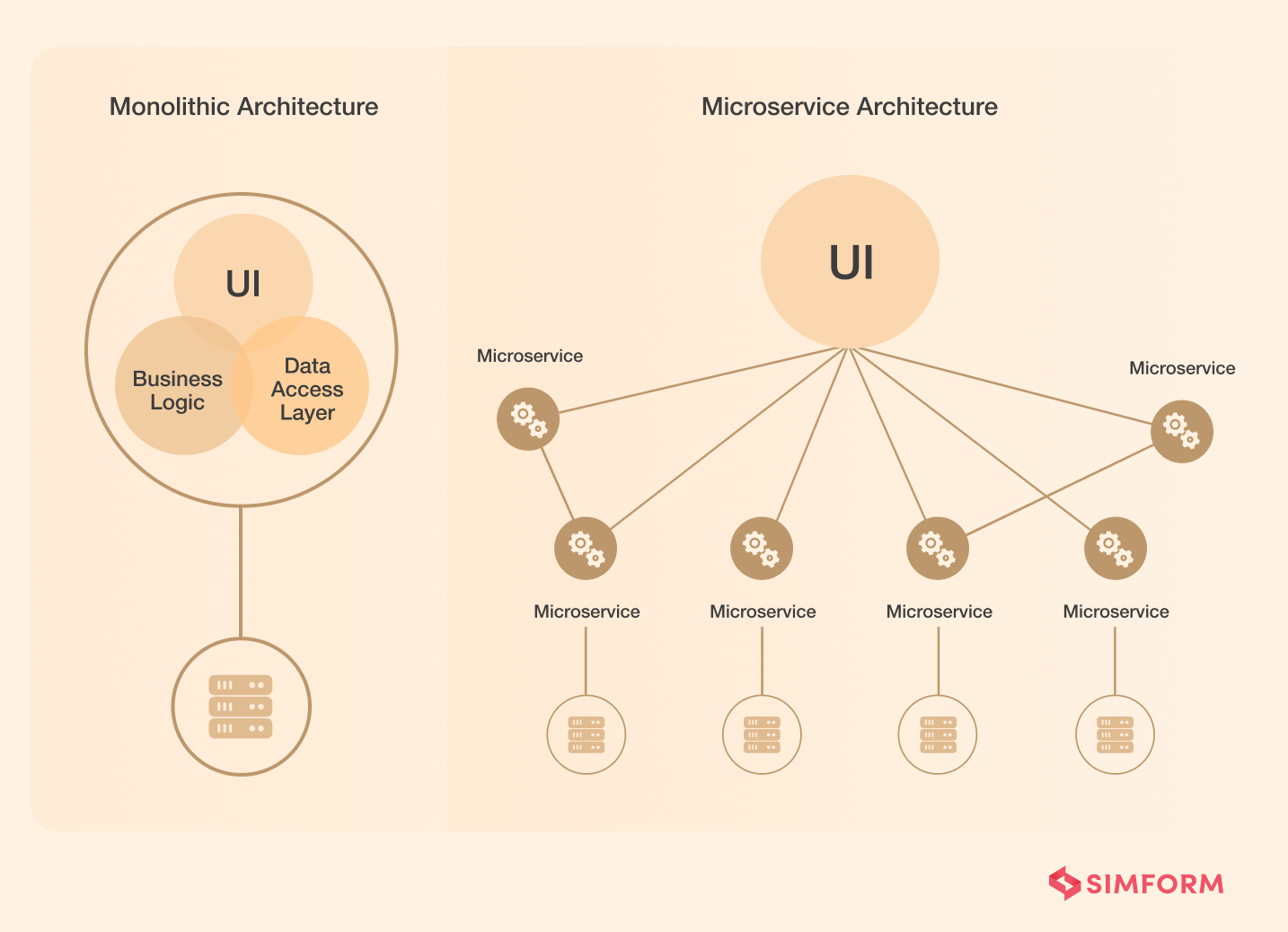
Advantages of microservices architecture
- Independent deployment: This distributed nature of the microservice architecture allows engineering teams to build and deploy modules independently. It means they don’t need to change the entire codebase just to add or update a single functionality.
- Easier scaling: Regarding scalability, microservices are lightyears ahead of monolithic. You can easily scale individual elements and the entire application when needed without affecting the existing application codebase.
- Tech agnostic: Microservices allow the team to choose the best technology for each feature. With this architecture, a single application can be built using multiple programming languages. Such flexibility allows managers to adopt all the latest trends for a tactical advantage.
- Failure isolation: Unlike monolith, the entire system won’t go down because of a single bug in the case of microservices. Users can still access the rest of the application and features even if a certain module doesn’t function properly. However, all of this stays true only if the application is designed for failure and the dependencies are managed skillfully.
- Easier organization and management: The microservices architecture is very much capable of reflecting a DevOps-oriented team structure- smaller and cross-functional teams. This also leads to teams having full autonomy over their module and executives being able to better manage the application as a whole.
Disadvantages of microservices architecture
- Too many cross-cutting concerns: While the microservices architecture is dubbed to be the best for scalable applications, it can also swarm you with a lot of cross-cutting concerns as you start scaling. If not implemented properly, you might have a difficult time finding synergy among all the different modules.
- Security challenges: In a microservices ecosystem, there’s a lot of exchange of information among various services. All this exchange of information can sometimes risk valuable information getting exposed. A microservices architecture requires careful monitoring of how the data is moving between applications.
- High operational overheads: The decentralized nature of microservices leads to an increase in the number of units and concerns. This comes with the operational overhead of managing and maintaining all these increased units.
- Complex testing: With multiple independent moving units, it’s extremely difficult to test out business flows in the case of microservices. You need to test out not just individual services but also how they interact with each other under various business flows.
How is microservice architecture making a difference in various business sectors?
Monoliths vs microservices: An objective comparison of the two software architectures
Performance
Performance can be measured in various ways, but for this comparison, we will discuss the performance, based purely on latency. Subsequently, it translates to load speeds and other parameters affecting end-user experiences.
The microservices architecture involves a constant exchange of information between various services. Each communication call comes with certain latency, which is the time taken for the information to get relayed from point A to point B. The individual latencies add up with multiple communication channels between various services. Under ideal conditions, the communication calls take place in parallel, and the net latency would be equal to that of the process with the highest latency.
In the case of monoliths, the communication calls are local. This leads to considerably lower latencies and thus improved performance.
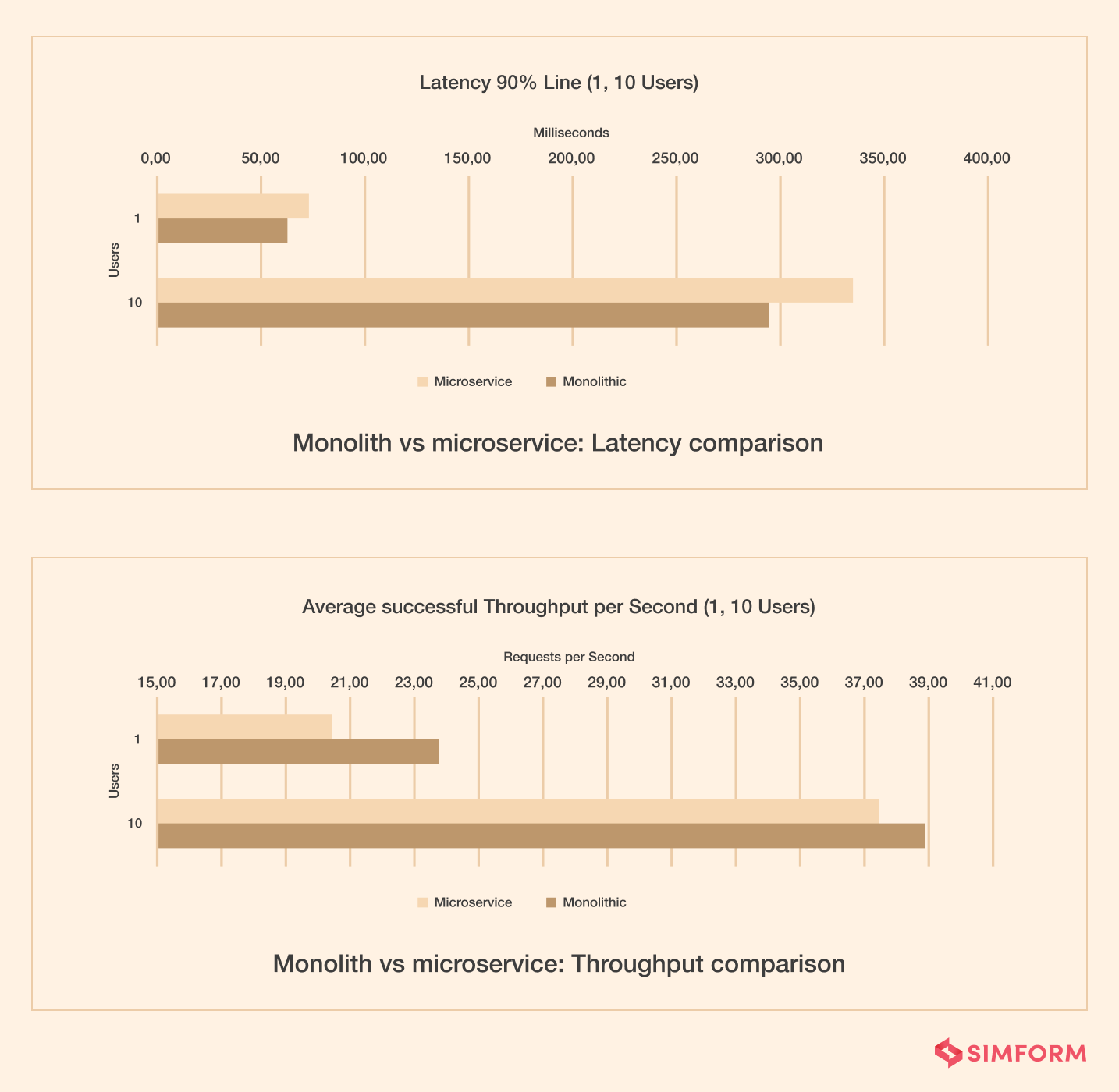
The above graph is a result obtained after measuring performance between monoliths and microservices. The results shown are for a complete system consisting of the user interface, REST API, business logic, and database.
In the microservices architecture, these were split into four separate Docker containers. On the other hand, the monolithic app was divided into three parts- UI, application, and database. And all three of these ran directly on a machine.
It clearly shows that microservices were 14% and 12% slower than monoliths in the two use cases. And similar results were obtained from experiments comparing the two architectures.
So when performance is based purely on latency, monoliths outshine microservices. However, you should also keep in mind that we are talking about fractions of seconds here. There’s so much more to successful applications.
Complexity
When speaking of complexity, it covers the complexity of development as well as maintaining the existing software.
Let’s start with the microservices architecture. With each new service coming into the picture, a microservices environment can grow exponentially. Each microservice has its own codebase. There are multiple microservices frameworks in action and potentially multiple languages being used to build the application. This is accompanied by the use of multiple versions of libraries since the releases are not in sync.
While these were the complexities involved during development, running a microservices application is no simple feat either. Containers and clusters come with complexities and demand great expertise for smooth management.
Monolithic applications, on the other hand, are relatively simple to develop. There’s only a single codebase with one library. Even running a monolithic application is simple up to a certain scale. It’s easier for developers to keep track of everything.
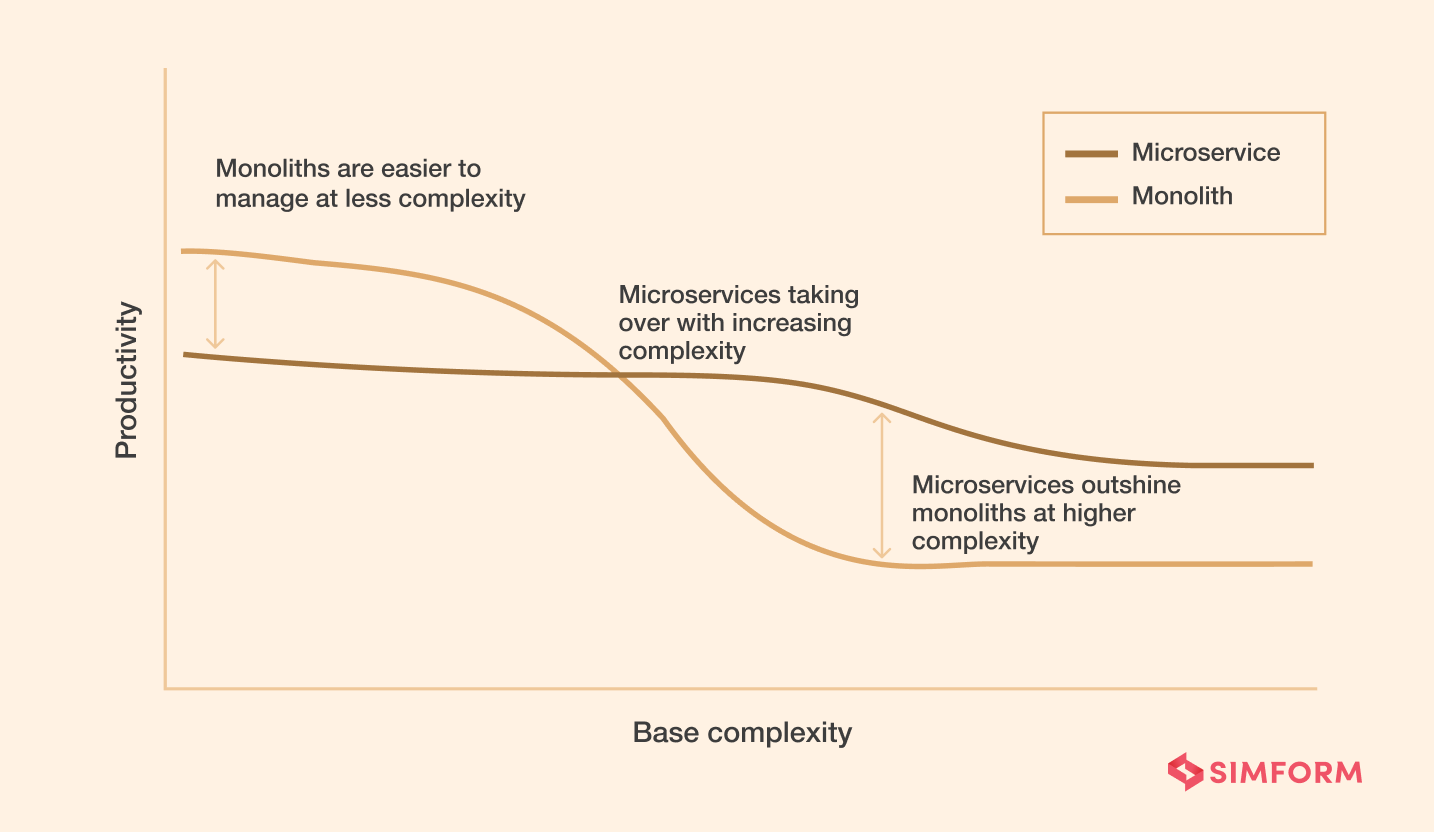
However, at large scales, things turn upside down. Legacy applications grow up to millions of lines of codes, and such entities can never be easier to manage. Most stories of successful migrations from monoliths to microservices started from monoliths becoming ridiculously difficult to manage and maintain.
So while it may seem that monolithic applications are simpler to develop and run, large-scale applications are better suited to microservices, even with all the complexities involved.
Testing
Testing is easier in the case of monoliths. There is only one codebase to go through and track while testing and debugging. While if we talk of the microservices architecture, comprehensive microservice testing is always a challenge.
Not only are you supposed to test out each microservice individually, but you also need to pay great attention to the testing of inter-microservice interaction. Business flows usually go through multiple microservices, and QA teams need to cover all the possible interaction scenarios.
Take a video-on-demand application under monolithic as well as microservices application architecture. Not only does the number of individual services increase in the case of microservices, but there are even more integrations and dependencies to test out.
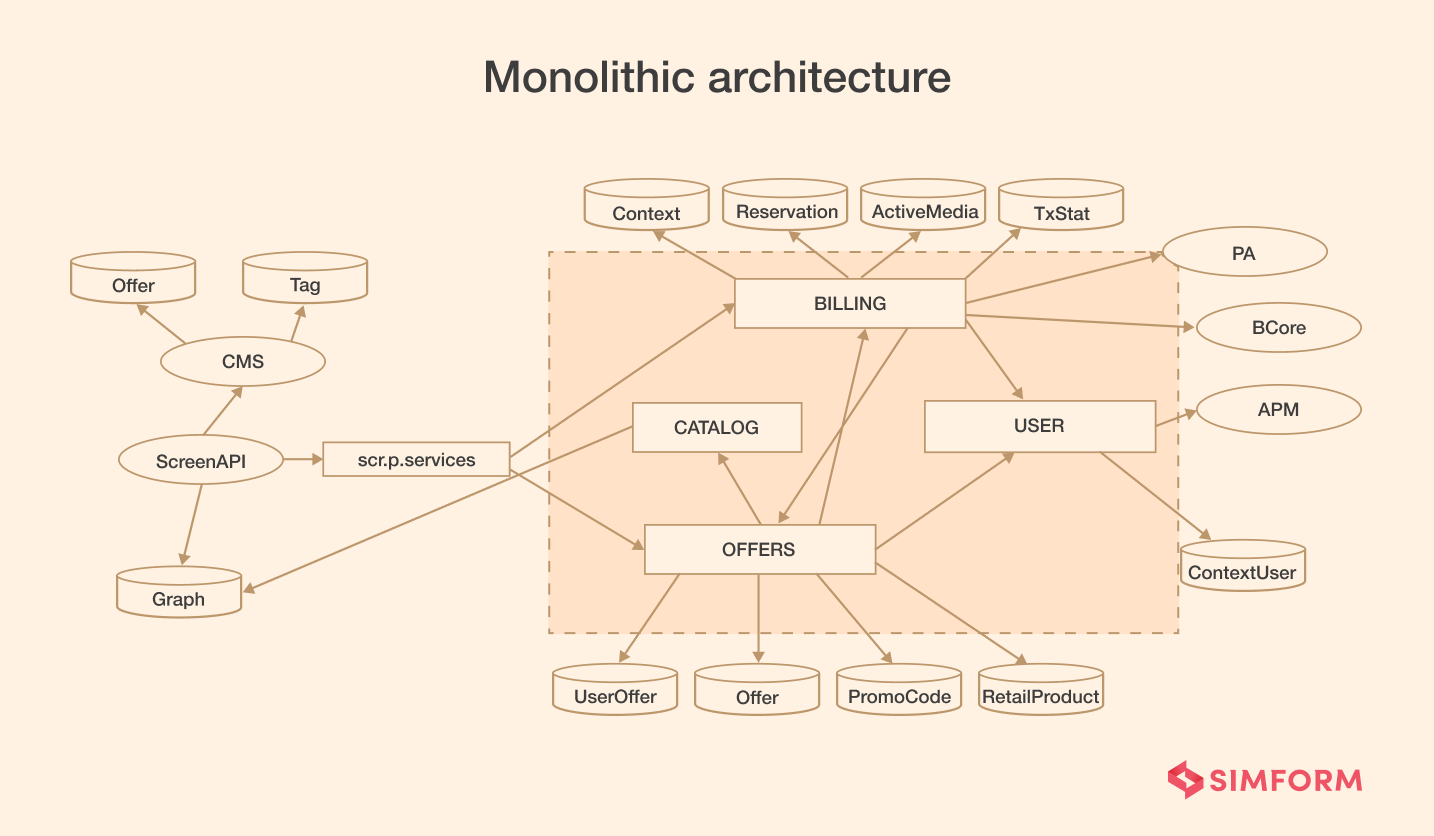
It might happen that, let’s say, services X, Y, Z pass all the tests at the individual level, but the business operation involving all three isn’t running. You might have to coordinate with all three teams to make changes and roll out updates for seamless operation. And that is much easier said than done.
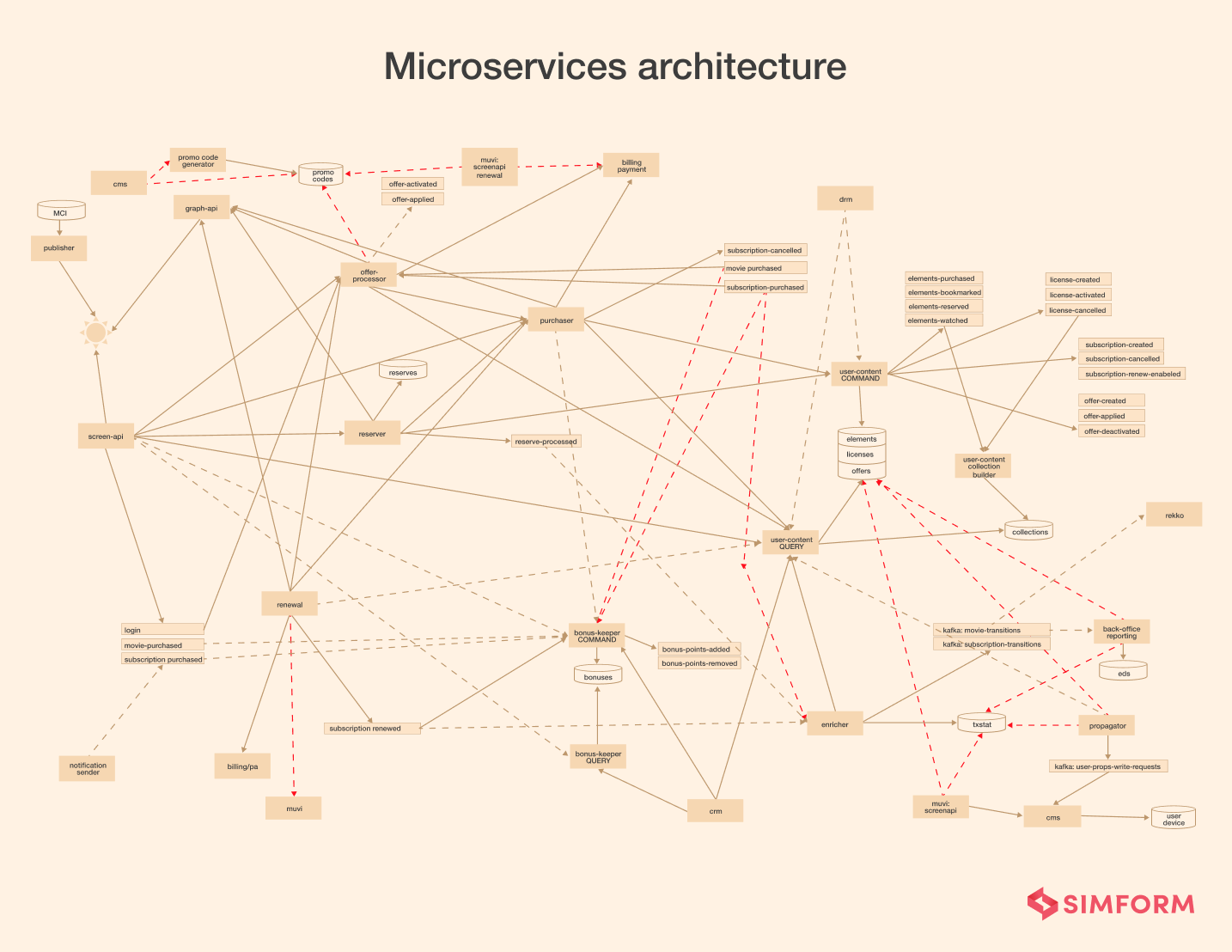
Based on the scale of services, microservices can present a lot of challenges when it comes to testing. Skilled QA engineers and intelligent automation are critical for microservices testing. And all of that comes with additional costs and resources.
However, microservices also come with the cushion of failure isolation. If some things go down, it’s less likely that the entire application will go down. However, in the case of monolithic applications, there are multiple potential single points of failure.
So even though microservices are more reliable, testing is easier in the case of monoliths.
Time to market
In the rapidly evolving digital ecosystem, the quicker you can move from an executive business decision to a product release, the better your chances of success.
One of the biggest reasons behind the immense popularity of microservices is the short time to market. The decoupled architecture makes it easy to roll out new features and continuously upgrade existing ones.
For instance, one of our clients had a legacy learning management system for school districts and wanted to undergo modernization. We used the microservices architecture to rehaul and rebuild the entire application in 12 months. While the decoupled nature of microservices facilitated the revamp, it has also enabled them to launch new features in a quick turnaround time.
It is at the back of this microservices infrastructure that they can now absorb feedback from pupils and parents to roll out new functionalities in no time. The architecture also supported seamless integration with 50+ systems which, in turn, helped build a dynamic and reliable analytics platform.
Individual microservices, being small entities, are easier to develop and update. It means developers can quickly build a microservice around a business capability and roll it out for users to try.
In the case of monoliths, every subsequent change can get difficult depending on the scale of application. It is a good idea to go for monolith architecture in the case of MVP, but full-fledged applications over this architecture are always going to come with high time-to-market.
Team structure
Team structures under conventional monolithic and microservices architectures are different. Under the microservices arrangement, you have smaller teams working on individual services and holding complete accountability for the same.
Whereas in the case of monoliths, there are generally large teams with multiple devs contributing to the same codebase but no one taking ownership of the entire build. Another issue of such a team structure is inefficient communication.
Since so many are involved, and almost everyone’s work affects everyone else, it’s extremely difficult to find synergy among the entire team. On top of that, where there are production and operation silos in monolithic organizations, poor communication reduces the quality of the entire process software’s quality.
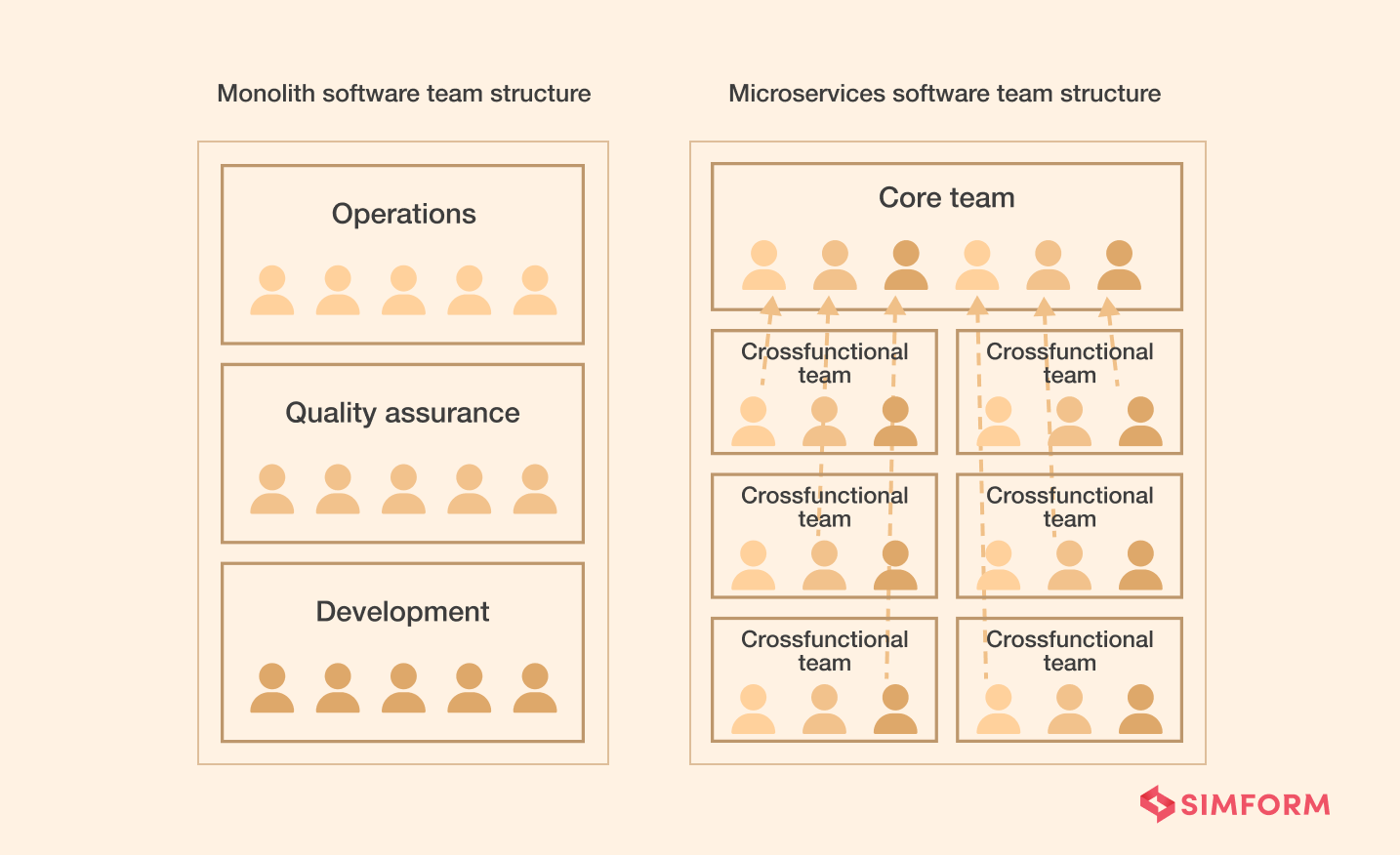
The microservices team usually comprises everyone from operations experts to quality engineers. This leads to faster builds, instant communication, and quick turnarounds. Additionally, the tech-agnostic nature of microservices allows you to hire just the right kind of experts for the team. You won’t struggle to find RoR devs just because you initially chose that. If it’s easier for you to get Python developers, microservices can let you build the next feature using that only.
With microservices, it’s much easier and natural to follow the DevOps principles and maintain an agile SDLC.
How Microservices are Transforming Industries: Use Cases from Capital One, Facebook, Uber, and more
Monoliths vs microservices: When to use
Now that you know the characteristics of both monolithic and microservices architectures, the next obvious question – When to use which one? Here are a few broader use cases for both architectures.
Monolithic architecture use cases
- Small applications: If there is a small and simple app that you wish to roll out quickly, then monolith architecture is the way to go. There will be just one codebase to take care of, which gives you a rapid turnaround time.
- MVP: Monolithic architecture also allows you to quickly build and release an MVP to gather feedback. This is especially beneficial when you are operating in a highly competitive market.
- Limited scaling: If you are confident of the future growth plans of the application and know that there would only be limited scaling, then you can choose this architecture. It’s much easier to manage the limited scope of such applications using monolithic architecture.
- Still in ideation phase: If your application is still in the ideation phase and you are figuring out stuff as you go, then choose monolith. It gives you quick iteration capabilities, and you can always shift to microservices as you scale in the future.
- Limited tech expertise: Being the traditional app development method, it’s much easier to source talent for monolithic projects. Microservices, on the other hand, require a lot of tech expertise which is not easy to source and also comes with a bigger price tag.
Microservices architecture use cases
- Large-scale applications: When it’s a huge application with multiple user journeys and a variety of modules, then microservices architecture presents you with just the right capabilities to manage this scale. Unsurprisingly, many legacy app migrations to a microservices approach stemmed from large-scale applications being difficult to manage within a monolith.
- Big data applications: Big data applications have a complex pipeline-oriented architecture, with each stage managing specific task(s). The pipeline collects, ingests, processes, and delivers data. With a microservices architecture, you can easily complement these stages with a microservice of their own.
- Real-time data processing applications: Netflix, YouTube, Soundcloud, etc., are examples of successful real-time applications. And it should come as no surprise that all of them use the microservices architecture. The publish-subscribe messaging pattern used in microservices makes it ideal for such applications.
- CPU-intensive applications: For an application consisting of CPU-intensive operations such as natural language processing, geographical index, etc., it’s better to keep such instances separated using a microservices architecture pattern. It allows developers to avoid running these processes every time they work on the application.
- Rapidly evolving applications: With new technologies and languages pushing the envelope for tech innovation, microservices help rapidly evolving applications stay relevant. It’s optimum to continue including latest technologies and strategies in the application without having to do everything from scratch for each update.
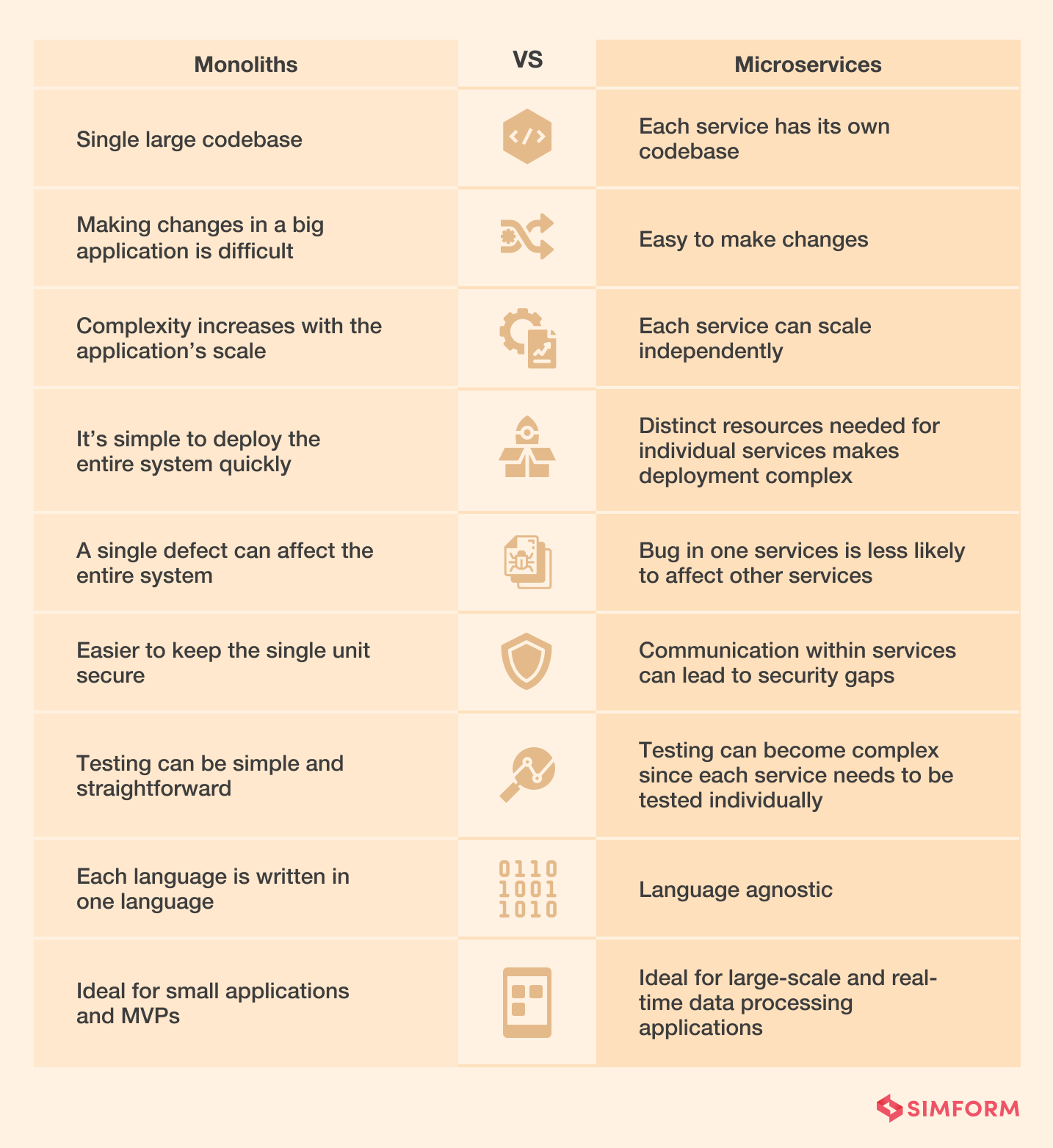
Monoliths vs microservices: How to choose the right architecture for your application
Despite the many advantages and disadvantages of these two architecture patterns, your biggest concern would be to identify the right one for your application. Well, there are several factors that you should consider before making the decision. Let’s go through some of those factors.
- Nature of the application: First and foremost, you should verify your application’s nature and see its most suitable architecture pattern. The use cases in the previous section can help you with this part.
- Business risk: The perks of the microservice architecture often make many feel that it is the only way to move forward. However, when it’s not needed, rushing with microservices can put a business at risk. Ensure you carefully go through all the possible requirements and risks for the project to ensure none of the development efforts go to waste.
- Infrastructure: You also need to take another look at your infrastructure before making a decision. Microservices architecture requires excellent cloud-based infrastructure for smooth operations.
- Cost: Speaking of infrastructure, there’s a cost associated with it. Finances are always a big concern for any app owner. With microservices, the costs can easily get out of hand with each upgrade. If you decide to go ahead with microservices architecture, make sure you have strong-enough finance to pursue it.
- Tech competency: At the end of the day, it’s going to be developers writing down lines of code for your monolithic or microservices application. It’s imperative that you are able to source the right kind of talent for your application.
Microservices can be tricky. It demands a detailed understanding of systems, business operations, microservices tooling, and whatnot. On top of that, it’s difficult to find the right developers and expertise capable of dealing with a microservice architecture. To hire the right talent, you again need microservices expertise.
We, at Simform, have helped multiple companies build scalable software or modernize their legacy system with a microservices architecture. Our team consists of expert software developers with versatility in software development. Feel free to contact us for expert microservices consulting and support for your project.
